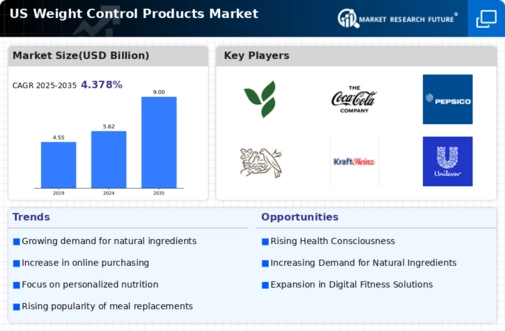The weight control-products market is characterized by a dynamic competitive landscape, driven by increasing consumer awareness regarding health and wellness. Key players are actively engaging in innovative strategies to capture market share and enhance their product offerings. Notably, companies such as Herbalife (US), Weight Watchers (US), and Nestle (CH) are focusing on digital transformation and personalized nutrition solutions. These strategies not only cater to evolving consumer preferences but also foster a competitive environment where agility and responsiveness are paramount.
In terms of business tactics, companies are increasingly localizing manufacturing and optimizing supply chains to enhance efficiency and reduce costs. The market appears moderately fragmented, with several key players exerting substantial influence. This collective presence of major companies shapes the competitive structure, as they vie for consumer loyalty through differentiated product offerings and targeted marketing strategies.
In October 2025, Herbalife (US) announced a partnership with a leading fitness app to integrate personalized meal plans and fitness tracking, enhancing user engagement and promoting holistic weight management. This strategic move underscores the growing importance of technology in the weight control-products market, as consumers seek comprehensive solutions that align with their lifestyle choices. By leveraging digital platforms, Herbalife aims to strengthen its market position and foster customer loyalty.
In September 2025, Weight Watchers (US) launched a new line of plant-based meal kits, reflecting a shift towards sustainable and health-conscious eating. This initiative not only diversifies their product portfolio but also aligns with current consumer trends favoring plant-based diets. The introduction of these meal kits is likely to attract a broader audience, positioning Weight Watchers as a leader in the evolving landscape of weight management solutions.
In August 2025, Nestle (CH) expanded its range of low-calorie snacks, emphasizing clean label ingredients and transparency in sourcing. This strategic expansion is indicative of a broader trend towards healthier snacking options, which resonates with health-conscious consumers. By focusing on product innovation and quality, Nestle aims to differentiate itself in a competitive market, appealing to consumers who prioritize health and wellness in their dietary choices.
As of November 2025, the competitive trends in the weight control-products market are increasingly defined by digitalization, sustainability, and the integration of artificial intelligence. Strategic alliances are becoming more prevalent, as companies recognize the value of collaboration in enhancing product offerings and market reach. Looking ahead, competitive differentiation is likely to evolve from traditional price-based competition to a focus on innovation, technology, and supply chain reliability, as companies strive to meet the diverse needs of health-conscious consumers.






















Leave a Comment